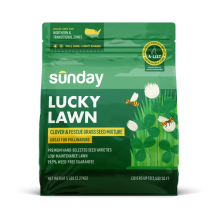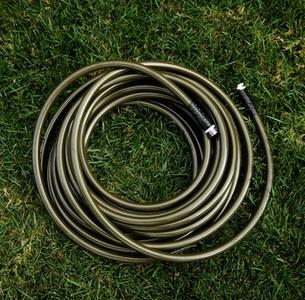Why clover?
Clover offers numerous advantages:
- Thrives in challenging conditions, such as shade and poor soils.
- Naturally suppresses weeds.
- Drought-tolerant.
- Fixes nitrogen in the soil, reducing the need for fertilization.
- Attracts and supports pollinators like honeybees.
Sunday Tip:
Strawberry clover is very similar in growth but has pink flowers instead of white for an extra pop of color.
Choosing the right clover for your lawn
White Clover (Trifolium repens) is highly resilient and ideal for regularly mowed lawns. Strawberry Clover adds a touch of pink, while newer varieties like 'Microclover' and 'mini clover' offer a lower profile for a more seamless lawn appearance. These microclover seeds are now more commonly seeded into lawns and are becoming easier to find.
For an easy start, Sunday's Lucky Lawn Grass Seed mix, combining fescue and microclover, simplifies creating a durable, clover-rich lawn.
How to seed clover in your lawn
Prep lawn for seeding
Before seeding, mow slightly lower than usual and remove grass clippings and lawn debris. This helps ensure the seeds reach the soil!
If needed, lightly rake or till the soil to prepare any thinning or bare areas of the lawn.
Select your clover seed
For the easiest seeding experience, opt for Lucky Lawn Grass Seed.
Adding pure clover seed to another grass seed mix? Clover should be 5-10% of the total mixture by weight.

Lucky Lawn Grass Seed
- Pollinator-friendly seed
- Fescue and microclover
- Requires fewer nutrients
- A-LIST-approved varieties
Plant seeds
Use a rotary or drop spreader to apply seeds evenly at the correct rate for best results. Start on your spreader’s lowest setting and slowly increase as needed to reach the desired coverage and seed rate.
Sunday seed rates
- For maintenance seeding or overseeding: 2 lbs. per 1000 sq. ft.
- For heavy repair, extremely weedy lawns, and new lawns: 5 lb per 1000 sq. ft.
*For size reference: 1000 sq. ft. is about the size of a volleyball court
Water correctly
Water in seed thoroughly but gently after applying to ensure uniform coverage and avoid washing away seeds.
For overseeding, water according to your regular watering schedule. You don’t need to water daily for this seeding method unless in dry climates.
For a new lawn or patching bare areas, water 1–2 times daily for 2-3 weeks until the grass is established (about 2 inches), then reduce watering to your regular schedule.
Caring for clover lawns
Mowing
Start mowing your new grass and clover once it reaches the proper mowing height.
Fertilizing
Clover reduces nitrogen needs but doesn't eliminate them. Early spring fertilization is key to helping balance grass and clover growth.
Sunday's custom lawn plans will ensure your clover lawn receives optimal nutrition.
Enhancing backyard biodiversity with clover
Incorporating clover into your lawn is a step toward supporting crucial pollinators. By diversifying your lawn with clover, you're providing critical resources for local pollinators and creating a healthier, more vibrant ecosystem in your backyard.
This movement towards sustainable lawn solutions is gaining traction among eco-conscious homeowners—and is easier than you think!
Ready for a change?
Discover how Sunday's custom plans and lawn care products can transform your yard into a thriving, biodiverse environment. Join us in creating healthier backyards for our planet.
Get a custom fertilizer plan
Our lawn engine uses satellite data to map out your lawn size and determine things like average rainfall, common weeds, and pest activity.
Cited sources
Planting and Maintaining a Bee Lawn. University of Minnesota Extension.
Low Maintenance Turf? Oregon State University.



















